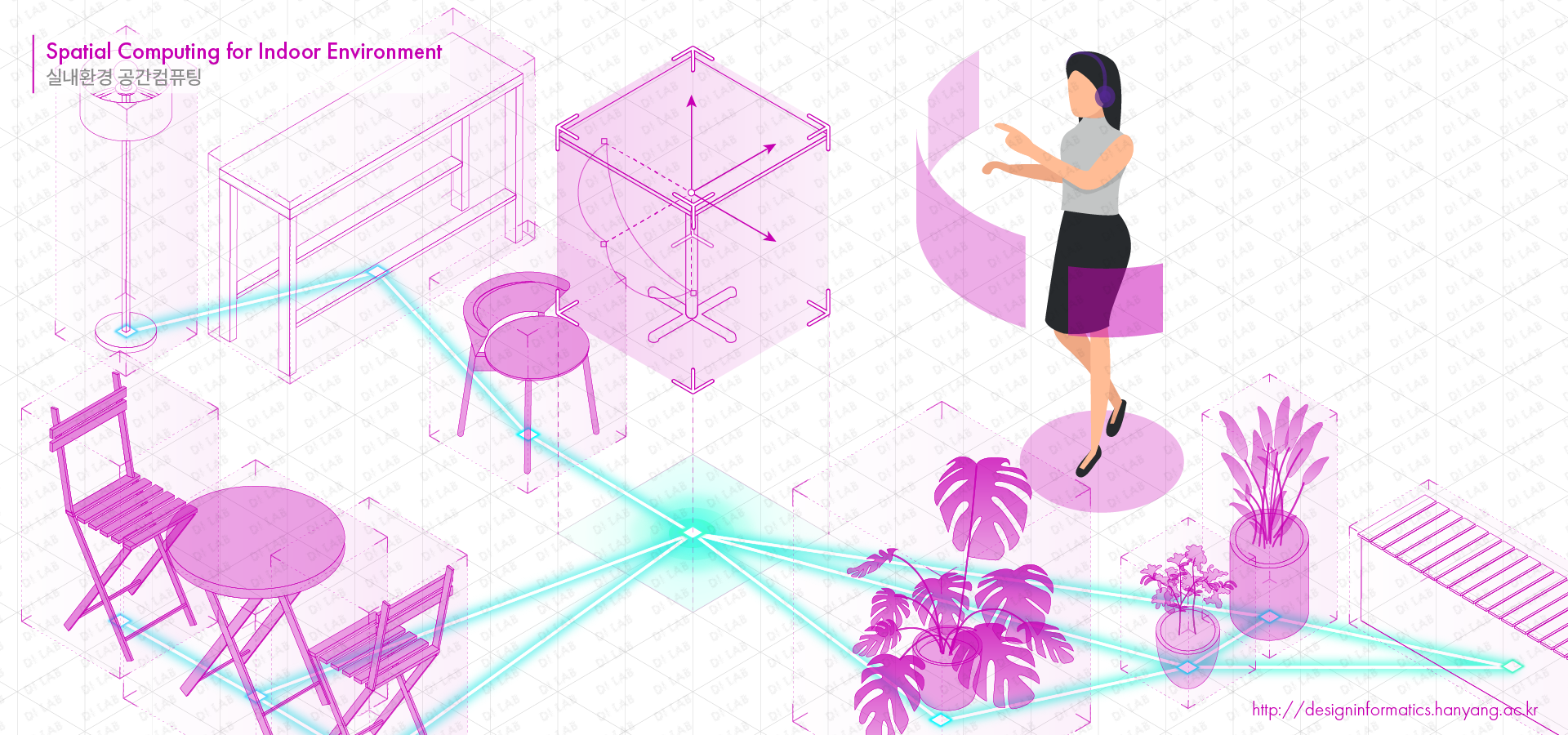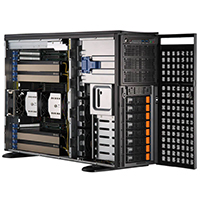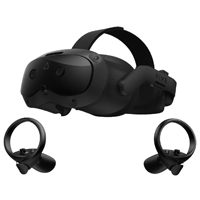WELCOME TO DILAB !
Design Informatics Lab (DILab) is a research laboratory dedicated to coordinating human and computer efforts to assist in the creative process. Our research focuses on developing information exploration methods and tools that leverage the intersection of design, artificial intelligence, and interaction science. We are interested in three research areas:
1
Artificial Intelligence in Design & Interaction Method, 2
3D Shape Generation & Editing Interfaces, 3
Spatial Computing for Indoor Environment. We welcome collaboration with academic institutions, companies, and public organizations to advance the field of design and support designers' creativity. If you are interested in collaboration please contact us at: hoonhello@hanyang.ac.kr
디자인 인포매틱스 연구실 (Design Informatics Lab; 이하 DILab)은 디자이너의 창의성을 지원하기 위한 혁신적인 인간-컴퓨터 협업 방식에 대한 연구를 활발하게 수행하고 있습니다. DILab은 디자인 과정을 돕기 위한 정보 탐색 방법 및 시스템을 개발하고 있으며, 디자인, 인공지능, 인터랙티브 기술 간 최첨단의 교차 지점을 포착하고 구현합니다. DILab은 세가지 연구 분야에 집중하고 있습니다:
1
인공지능 디자인과 인터랙션 방법, 2
3D 형태 생성 및 편집 인터페이스, 3
실내환경 공간컴퓨팅.협업 관련 문의는 아래 이메일로 보내주시기 바랍니다:
hoonhello@hanyang.ac.kr
Research keywords:
Computational Design
Design Automation
Design Exploration
Generative AI
Action-based AI Interaction

1
Artificial Intelligence in Design & Interaction MethodsWe focus on developing methodologies to enhance the effectiveness of information exploration in extensive information spaces using artificial intelligence. Specifically, we investigate interaction designs that accurately derive information matching users' intents based on their behavior. This involves methods for collecting and analyzing user action data, developing inference models from this data, and striving to better comprehend and predict user preferences and intentions. This field not only advances technology but also significantly improves the user experience (UX).
1
인공지능 디자인과 인터랙션 방법우리는 방대한 정보 공간(Information Space)에서 인공지능을 활용하여 사용자가 더 효과적으로 정보를 탐색할 수 있도록 지원하는 방법론 개발에 중점을 둡니다. 특히 사용자의 행동을 기반으로 한 의도 추론 기법을 개발하여, 사용자가 실제 원하는 정보나 서비스를 정확하게 도출해 낼 수 있는 인터랙션 디자인을 연구합니다. 이를 위해 사용자 행동 데이터의 정확한 수집 및 분석 방법, 그리고 이를 기반으로 한 추론 모델의 개발에 주력하고 있으며, 사용자의 선호도와 의도를 보다 명확하게 파악하고 예측하는 것이 주된 목표입니다. 이 분야는 기술적 진보뿐만 아니라, 사용자 경험(UX) 향상에도 크게 기여할 수 있는 잠재력을 지니고 있습니다.
Example Papers:
-
BIGaze: An eye-gaze action-guided Bayesian information gain framework for information exploration
Advanced Engineering Informatics (2023) 58: 102159
SCIE(Computer Science, Artificial Intelligence; Multidisciplinary, IF=8.800) -
CreativeSearch: Proactive design exploration system with Bayesian information gain and information entropy
Automation in Construction (2022) 142: 104502
SCIE(Construction & Building Technology, IF=10.517) -
BIGexplore: Bayesian Information Gain Framework for Information Exploration
ACM CHI 2022 Paper. New Orleans, USA
~SCIE(BKCSA003, h5-index=113) -
Designer-Centric Spatial Design Support
Automation in Construction (2022) 137: 104195
SCIE(Construction & Building Technology, IF=10.517)

2
3D Shape Generation & Editing InterfacesWe are dedicated to developing new algorithms and user interfaces for reconstructing 3D shapes using generative artificial intelligence. Our goal is to swiftly and effectively generate and edit 3D shapes by leveraging users' multimodal information (visual, auditory, textual) and behavioral data (user input history, gaze, biometric data). This capability enables real-time synthesis and modification of 3D models tailored to user intentions. This field holds broad applications in areas such as 3D design, virtual reality, and augmented reality, promising innovation in digital content creation and interaction methods.
2
3D 형태 생성 및 편집 인터페이스우리는 생성형 인공지능을 활용하여 3D 형태(shape)를 창조하고 수정하는 새로운 알고리즘과 사용자 인터페이스를 개발하는 데 주력하고 있습니다. 사용자의 멀티모달 정보(시각, 음성, 텍스트)와 행동 데이터(사용자의 입력 기록, 시선, 생체 데이터)를 활용하여 신속하고 효과적으로 3D 형태를 생성하고 편집하는 기술을 개발하는 것이 목표입니다. 이를 통해 사용자의 의도에 딱 맞는 3D 모델을 실시간으로 합성하고 수정할 수 있는 능력을 제공합니다. 이 분야는 3D 디자인, 가상 현실 및 증강 현실과 같은 분야에서 광범위하게 응용될 수 있으며, 향후 디지털 콘텐츠 생성과 인터랙션 방식에 혁신을 가져올 것입니다.
Example Papers:
-
GenPara: Enhancing the 3D Design Editing Process by Inferring Users' Regions of Interest with Text-Conditional Shape Parameters
ACM CHI 2025 Paper. Yokohama, Japan
~SCIE(BKCSA003, h5-index=129) -
Generating Command Modeling and Design Graphs with Data Augmentation for Enhanced 3D Modeling Support
Advanced Engineering Informatics (2025) 68: 103644
SCIE(Computer Science, Artificial Intelligence; Multidisciplinary, IF=9.9) -
The Impact of Sketch-guided vs. Prompt-guided 3D Generative AIs on the Design Exploration Process
ACM CHI 2024 Paper. Honolulu, USA
~SCIE(BKCSA003, h5-index=113) -
BOgen: Generating Part-Level 3D Designs Based on User Intention Inference through Bayesian Optimization and Variational Autoencoder
Prepr.arXiv preprint (2023) arXiv:2312.02557
-
3D Computational Sketch Synthesis Framework: Assisting Design Exploration Through Generating Variations of User Input Sketch and Interactive 3D Model Reconstruction
Computer-Aided Design (2020) 120: 102789
SCI(Computer Science, Software Engineering, IF=2.947)

3
Spatial Computing for Indoor EnvironmentWe aim to develop technologies that quantify spatial design elements and apply them in extended reality environments. Our focus is on automating the construction of indoor environments by analyzing interior styles, color and material relationships, and furniture layout arrangements. Additionally, we incorporate recommendation systems to enhance this process. Using spatial computing technologies, our research explores the capability to transform real spaces into virtual spaces with diverse forms and functionalities in real-time, thereby redefining users' experiences in indoor environments.
3
실내환경 공간컴퓨팅우리는 공간디자인 요소들을 정량화하고 혼합현실 환경에 적용할 수 있는 기술을 개발하는 것을 목표로 합니다. 특히, 인테리어 스타일, 색채와 재질 관계, 가구 배치 및 추천 시스템을 통해 실내환경을 자동으로 구축하는 것에 중점을 두고 있습니다. 이 분야는 공간 컴퓨팅 기술을 활용하여 실제 공간을 가상의 다양한 형태와 기능을 갖춘 공간으로 실시간 변환할 수 있는 능력을 연구하며, 이를 통해 사용자의 실내 환경 경험을 새롭게 정의합니다.
Example Papers:
-
HAPshop: How Haptic Information Affects Consumers’ Purchase Intentions Toward Online Products
Computers in Human Behavior (2025) 166: 108580
SSCI(Psychology, Experimental; Psychology, Multidisciplinary, IF=8.9) -
Enhancing Design Activity and Review Experience Through Hybridizing Desktop and Virtual Environments
Journal of Interior Design (2023) 48.1
A&HCI(Architecture) -
Analysis of Pairings of Colors and Materials of Furnishings in Interior Design with a Data-Driven Framework
Journal of Computational Design and Engineering (2022) 9.6: 2419-2438
SCIE(Computer Science, Artificial Intelligence; Engineering, Multidisciplinary, IF=6.167) -
Pixel of Matter: New Ways of Seeing with an Active Volumetric Filmmaking System
Leonardo (SIGGRAPH - Art Paper) (2020) 53.4: 434-437
A&HCI(Art, Art & Architecture) -
C-Space: An Interactive Prototyping Platform for Collaborative Spatial Design Exploration
ACM CHI 2020 Paper. Honolulu, USA
~SCIE(BKCSA003, h5-index=113)
CORE EQUIPMENTS @DILAB

Supermicro GPU Workstation
Deep Learning Workstation (RTX6000 Pro Blackwell*4)
Deep Learning Workstation (RTX6000 Pro Blackwell*4)

Vive Focus Vision Hybrid
Head-Mounted Display
Head-Mounted Display

Tobii Pro Spectrum 1200Hz
Eye Tracker
Eye Tracker

Supermicro GPU Workstation
Deep Learning Workstation (A6000*4)
Deep Learning Workstation (A6000*4)

Supermicro A+ SuperWorkStation
Deep Learning Workstation (A6000*2)
Deep Learning Workstation (A6000*2)

Lightform 2
Sound Reactive AR Projector
Sound Reactive AR Projector

Oculus Quest 2
Head-Mounted Display
Head-Mounted Display

HTC VIVE Pro Full Kit
Head-Mounted Display
Head-Mounted Display

Magic Leap
Head-Mounted Display
Head-Mounted Display

Emotive-EPOC+
14-Channel Wireless EEG Headset
14-Channel Wireless EEG Headset

E4 Wristband
Real-time Physiological Signal Sensor
Real-time Physiological Signal Sensor

Wacom Cintiq 27QHD
Pen Display
Pen Display

Ultimaker 2, 3+, S5
3D Printer
3D Printer